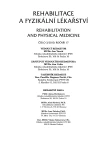Proposed Evaluation of Muscular Strength of Pelvic Floor in Female Patients with or without Incontinence
Authors:
M. Hagovská; P. Takáč
Authors‘ workplace:
V spolupráci s Kúpeľným zariadením Liptovské liečebné kúpele Lúčky, a. s.
; Klinika fyziatrie, balneológie a liečebnej rehabilitácie LF UPJŠ a FN L. Pasteura, Košice
prednosta doc. MUDr. P. Takáč, Ph. D.
Published in:
Rehabil. fyz. Lék., 17, 2010, No. 3, pp. 87-94.
Category:
Original Papers
Overview
The above paper describes a proposal for assessment of pelvic floor muscles strength. To the mentioned muscles belong m. levator ani and m. coccygeus. The activity of the above muscles was scanned by a vaginal probe with the aid of Biofeedback – EMG module. Also the activity of m. rectus abdominis was recorded by means of stick on (self adhesive) surface probe from the area of m. rectus abdominis insertion. The set value in electromyogram was 60 μV at the maximum, which was established as the optimum sensitivity for all standard EMG measurements. Based on the data analysis of 66 patient sample after vaginal and abdominal hysterectomy in incontinent patients (stress incontinence 1.degree) and continent patients we managed by the biofeedback differentiate pelvic floor muscle strength from 1 to 5 muscle strength degree.
Key words:
urinary stress incontinence, biofeedback, pelvic floor
Sources
1. BO, K., SHERBURN, M.: Evaluation of female pelvic - floor muscle function and strength. http://127.0.0.1:4664/search?q=Evaluation+of+Female+Pelvic%2DFloor+Muscle+Function+and+Strength&flags=1048576&s=Ajdx15e3zHi5lrWKL9FmN6zNezc, marec 2005.
2. DANNECKER, CH., WOLF,V., RAAB, R., HEPP, H., ANTHUBER, CH.: EMG – biofeedback assited pelvic floor muscle training is an effective therapy of stress urinary or mixed incontinence: a 7 year experience with 390 patients. A. Gynecol. Obset., 2005, DOI 10.1007/s 00404 – 005 -0011 – 4.
3. GOODE, P. S., BURGIO, K. L., LOCHER, J. L., ROTH, D. L., UMLAUF, M. G., RICHTER, H. E., VARNER, R. E., LLOYD, L. K.: Effect of behavioral training with or without pelvic floor electrical stimulatoin on stress incontinence in women. JAMA, roč. 290, 2003, č. 3, s. 345-352.
4. KOLAŘÍK, D., KRAHULEC, P.: Elektrická stimulace. Metody používané především k léčbe urgentní inkontinence moči. In: Halaška M. a kol.: Urogynekologie. Galén, Praha, 2004, s. 81-87. ISBN 8072622722.
5. LAYCOCK, J., JERWOOD, D.: Pelvic floor asssessment:the P.E.R.F.E.C.T. scheme. Physiotherapy, 87, 2001, s. 631.
6. NEUMANN, P. B., GRIMMER, K. A., DEENADAYALAN, Y.: Pelvic floor muscle training and adjunctive therapies for the treatment of stress urinary incontinence in women:a systematic rewiew. Journal List BMC Womens Health, 2006.
7. PULLMAN, S. L., GOODIN, M. D, MARQUINEZ, M. D. S., TABBAL, M. D. M., RUBIN, M. D.: Clinical utility of surface EMG report of the therapeutics and technology assessment. Subcommittee of the American Academy of Neurology. Neurology, 55, 2000, s. 171-177.
8. THOMPSON, J. OęSULLIVAN, P., BRIFFA, K., NEUMANN, P.: Corrrect performance of pelvic floor muscle excercises counts. Physiotherapy Research Update, 2007.
Labels
Physiotherapist, university degree Rehabilitation Sports medicineArticle was published in
Rehabilitation & Physical Medicine

2010 Issue 3
Most read in this issue
- Tietze’s Syndrome Versus Multiple Myeloma
- Clinical Study of High-induction Electromagnetic Stimulator SALUS Talent
- Rehabilitation in Orofacial Region in Cases of Central Paresis of Facial Nerve
- Application of Electrotherapeutic Currents of the TENS Type in Physiotherapy
